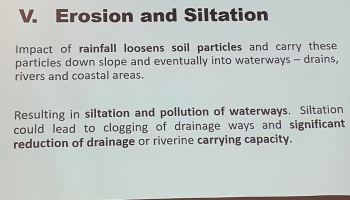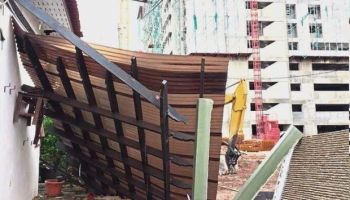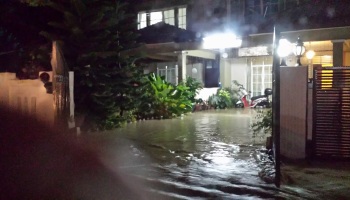 |
A drone picture of the collapsed beams along
Jalan Tun Sardon leading to Balik Pulau on the left while Jalan Paya
Terubong on the right leads to Relau.— CHAN BOON KAI/The Star
|
 |
(Above) A closer view of the collapsed beams.
(Right) The affected section of the project overlooking Jalan Paya
Terubong heading to Relau in the background.
|
| Tragic Situation: (Top) A landslide at the construction site in Jalan Bukit Kukus, Paya Terubong, caused four containers to be covered with mud - Bernama, Closed call:(Right below) Survivors of the landslide surveying the scene |
Checks show projects did not follow SOP
GEORGE TOWN: As the search and rescue operation for seven buried foreign workers at a construction site in Paya Terubong is going on, shocking information has surfaced that not a single construction site in Penang is following the soil erosion mitigation plan stipulated in their project approvals.
The Star has learnt that the state government has launched Ops Lumpur shortly after the general election, requiring enforcement officers from the local councils to inspect and report on every construction site in all five districts in the state.
A consultant civil engineer familiar with Ops Lumpur claimed that every single construction project did not observe the soil erosion mitigation plan.
He said Ops Lumpur was overseen directly by state exco members and enforcement officers were required to visit the sites.
"Their reports shocked the state exco members. Every contractor failed to do soil erosion measures in every site.
“Now you know why streams near construction site are always yellow when it rains,” he said.
The consultant engineer said the state went after developers who claimed they were not aware and blamed the contractors.
“Civil engineers are often disgusted when they do site visits because it is common for us to see that the soil erosion mitigation plans are never followed,” he said.
The consultant said it was easy to inspect construction sites and check on the progress and questioned whether state government agencies regularly conducted scheduled and surprise visits.
“How often do they conduct spot checks? How strictly do they conduct enforcement rounds on construction sites? If we keep contractors on their toes all the time, we might not have so many landslides,” he said, referring to the latest landslide in Bukit Kukus, the site of a hillside highway from Paya Terubong to Bukit Jambul is being built.
A teh tarik-coloured stream was observed flowing between Jalan Paya Terubong and the barred entrance to the highway construction site yesterday.
It has been raining almost every day in Penang this week.
In yesterday’s incident, rescue team found one survivor and two dead bodies. At press time, seven are still missing.
The Fire and Rescue Department received a distress call about the landslide at 1.56pm.
An Indonesian worker who only wished to be known as Endo, 36, said three of his relatives from Sulawesi were trapped in the landslide and he was working in another nearby construction site.
“It rained all night (Thursday). The rain stopped at 9am (yesterday) and resumed at 1pm. At my site, all of us stayed in our quarters and didn’t work because of the rain.
“I got a call from others that my relatives are missing. So, now I’ll just wait,” he said.
Last Thursday, 14 concrete beams measuring 25m long each, crashed down from an elevated section of the highway.
No injuries were reported and a stop-work order was issued pending investigations of the collapse.
Chief Minister Chow Kon Yeow, who visited the site with several state exco members, said he reminded rescue workers to be wary while searching for the missing victims because the rain could have rendered the slopes unstable.
“All work has stopped here and the contractor was about to send in its report on the collapse of the concrete beams on Oct 11,” he said, adding that the place where the beams collapsed was far from the landslide. - The Star by arnold lohlo tern chern
Water from stream identified as main cause of landslide
GEORGE TOWN: Water flow from a stream on the hilly area in Jalan Bukit Kukus, Paya Terubong, near here has been identified as among the cause of the landslide.
Azhari Ahmad, who is Mineral and Geoscience Department (JMG) director for Perlis, Kedah and Penang, said the finding was made based on its inspection and monitoring since Saturday.
“The JMG team identified several factors that caused the landslide, resulting in all containers on the hill slope to slide down with the earth.
“The main factor that caused the landslide is the water flow from a stream near the slope and heavy rain since Friday morning caused the water to overflow,” he told reporters yesterday.
Azhari said the department had taken immediate measure by diverting the flow of water from the stream elsewhere to avoid worsening the situation, especially during the search and rescue (SAR) operation.
He said further inspection conducted at 7.30am yesterday found the water flow on the slope was lesser but the department would continue to monitor the situation with equipment from the Special Malaysia Disaster Assistance and Rescue Team to ensure the safety of SAR personnel.
He said based on observation and inspection at the scene, the department found the location of the landslide to be at the concave slope which easily collected water.
“But we do not rule out the possibility of a follow-up landslide in the area due to the soil structure and there is still water flowing that can cause landslide.
“We have also advised the rescue team to stop operation immediately if it rains as it could cause another landslide,” he said.
Azhari said the department was assisting the rescue team in the SAR operation and did not rule out the possibility of it conducting further investigation to determine the actual cause of the landslide.
“We hope for fine weather and no rain so that the SAR operation can be continued until all the victims are found,” he said.
The landslide occurred at about 1.30pm last Friday.
The tragedy occurred following heavy rain in the state from Thursday afternoon until noon the following day, causing the landslide at the container and kongsi area at the Bukit Kukus paired road construction site.
Source: Bernama, Reports by LO TERN CHERN, N.TRISHA and R.SEKARAN
Related stories:



























